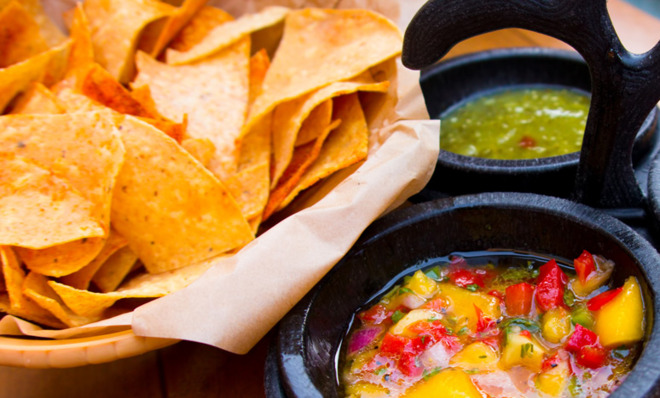11 things you didn't know about chip engineering
Your average, unsullied Pringle is a hyperbolic paraboloid; its equation is (x^2)/(a^2) - (y^2)/(b^2) = z/c. Really.


Surprisingly elegant engineering and rigorous testing goes into the production of chips. Not the micro kind that are running your computer but the potato, corn, and tortilla kind whose crumbs are all over your keyboard. Here are 11 things you might not know about America's favorite snack.
1. Supercomputers keep your Pringles pristine
You're probably wondering about the double-curved shape of a Pringles chip, and what its technical mathematical name is. Wonder no longer. Your average, unsullied Pringle is a hyperbolic paraboloid; its equation is (x^2)/(a^2) - (y^2)/(b^2) = z/c. Here's where things get interesting, though (as if hyperbolic paraboloids weren't interesting enough). Proctor & Gamble doesn't just shove a bunch of Pringles in a can and call it a day. Rather, they use supercomputers to keep conditions just right to make sure the chips make it from their factory to your house unmolested.
The Week
Escape your echo chamber. Get the facts behind the news, plus analysis from multiple perspectives.

Sign up for The Week's Free Newsletters
From our morning news briefing to a weekly Good News Newsletter, get the best of The Week delivered directly to your inbox.
From our morning news briefing to a weekly Good News Newsletter, get the best of The Week delivered directly to your inbox.
2. The FDA took issue with Pringles being called "chips"
So Pringles' competitors were none to happy with their new canister-borne competition, and went to the Food and Drug Administration with a complaint. Pringles, they argued, aren't technically "chips" of anything; they're freakish mathematical abominations! (I'm paraphrasing.) The FDA concurred, and mandated that if Pringles wanted to use the c-word, they were to refer to themselves as "potato chips made from dried potatoes."
3. The Doritos Locos Taco required the reinvention of the chip
So it's 3 a.m. and you've been reading the Bible and now you've got the munchies bad, man, and, like, dude, Taco Bell! You're probably going to order a Doritos Locos taco. I say "probably" because since their introduction, 450 million such tacos have been sold. Now you're probably thinking, well yeah, what an obvious idea. Sprinkle Doritos dust on a taco shell and you're in business.
A free daily email with the biggest news stories of the day – and the best features from TheWeek.com
Not so fast. Engineering the Doritos Locos required Taco Bell to basically reinvent the taco. Really. Chip engineers encountered three nearly insurmountable problems while pursuing their tasty new idea. First, unflavored taco shells and unflavored Doritos chips taste nothing alike. So when the seasoning was first applied to the taco shells, everyone realized that they were actually pretty gross. Scientists were thus forced to reconsider the taco shell formula. (Taco shells have a formula.)
What's more, you can't apply the Doritos seasoning to a taco shell the same way you do for a Doritos tortilla. Your average Dorito is a triangle (here I am excluding their extreme 3-D varieties). Your average taco shell is round and curved. Whereas the tumbling process for one will naturally apply zesty seasonings very evenly, the same process for a taco will result in a half-bland shell with a chewed-bubble-gum-sized glob of seasoning on one end. Not cool. (Though possibly cool ranch.) So the process had to be reconsidered. Which led to the third major problem.
See, when you get a bag of Doritos, you've got mostly big, crunchy chips, but you also have a lot of broken ones down at the bottom that you end up funneling into your mouth during that last satisfying go at the bag before feeling awful about your terrible diet and how it's affecting your health and relationships. (Or maybe that's just me.) The point is the tumbling barrels used to apply the seasoning to Doritos don't have to be good; they just have to be good enough. But that doesn't work for taco shells. Every taco shell must maintain its structural integrity from A to Z; from manufacturing, tumbling (the seasoning is basically applied in machines like giant clothes dryers), shipping to Taco Bells, taco assembly, insertion in the bag, and finally, to your kitchen table, or on the floor next to your Xbox controller and bottle of whiskey.
So Taco Bell had to reinvent everything, and seasonings are applied evenly to the new, re-engineered, chemically compatible tacos in what amounts to a sealed nacho cheese gas chamber.
4. It's not sunlight that makes sun chips so delectable
Actually, to get just the right amount of zest, Sun Chips use something with a little more kick than mere sunlight. They use pork enzymes. For flavor.
5. Doritos were invented at Disneyland
At Casa de Fritos in Disneyland (I swear I'm not making any of this up), extra tortillas were cut up, lightly fried, seasoned, and served. The resulting snack was popular. When a Frito-Lay executive discovered the goodie, he quickly had the papers drawn up and soon brought to the general public this Disney-born triangular gateway to heaven.
(Want a bonus bit of Disney trivia completely unrelated to chips? Richard Nixon's infamous "I am not a crook" press conference was held on November 17, 1973 at Walt Disney World.)
6. Sun Chips earned the ire of America for being too noisy
Nobody complains about the pork enzymes, but everybody hated the biodegradable packaging first used by Sun Chips in 2010. The problem was that, to hell with the environment, the bags were just too damn noisy. They were eventually redesigned and replaced. (The bags. Not the Americans.)
7. Ketchup-flavored chips are a thing
I first encountered ketchup-flavored chips in Afghanistan, where they were imported from United Arab Emirates. Apparently I've been living in a box, because they're reportedly also very popular in Canada, which is reason enough, if you ask me, to send in John Candy and Rhea Perlman.
8. Fritos and Cheetos are brothers
When he invented Fritos, you would think Elmer Doolin would have been satisfied with achieving immortality. But he was just getting started. Years later, he went on to invent Cheetos.
9. The word "funyuns" was the silver medal
After inventing a new onion-flavored snack, Frito-Lay wanted to call them OnYums. Alas, that Oscar Wilde-like play on words was already taken. Jim Albright, a professor at University of North Texas, came up with the next best thing: "Funyuns."
10. Technically, "nachos" needs an apostrophe
It's weird to think that nachos even needed to be invented. Chips, cheese, jalapeños — there was a time when people had no idea that such ingredients could be combined, let alone form the core of the single greatest culinary endeavor since the doughnut. In 1943, the head waiter at a border town restaurant in Mexico found himself having to improvise a dish for a group of Army wives who showed up after closing. Using the few remaining ingredients in the kitchen, Ignacio "Nacho" Anaya served up "Nacho's special."
11. Space aliens might know what Doritos are
In 2008, as part of some inexplicable marketing effort, Frito-Lay targeted a 30-second commercial at a potentially inhabited solar system 42 light years away. When the aliens finally come and destroy us, it's because we deserve it.
More from MentalFloss...


